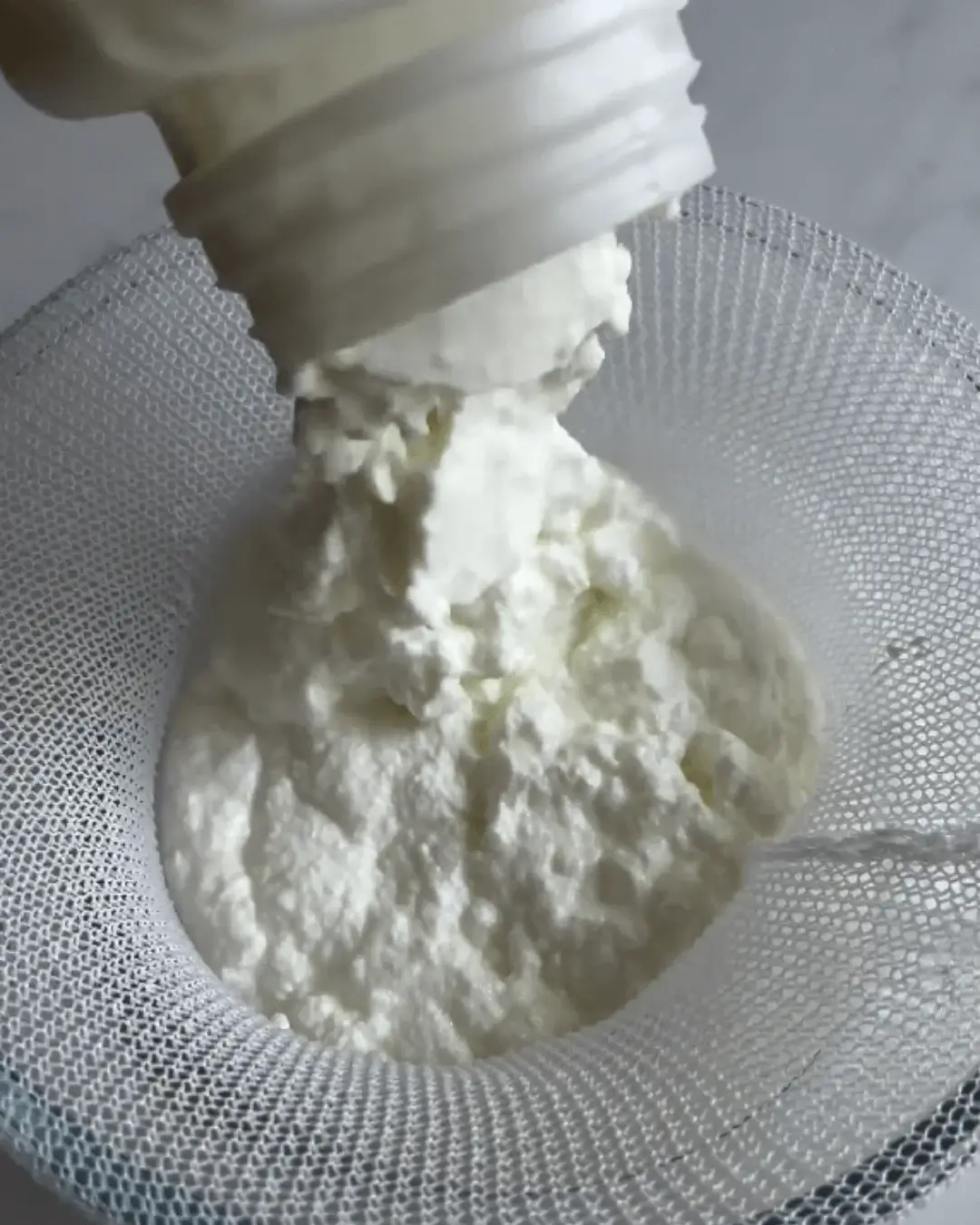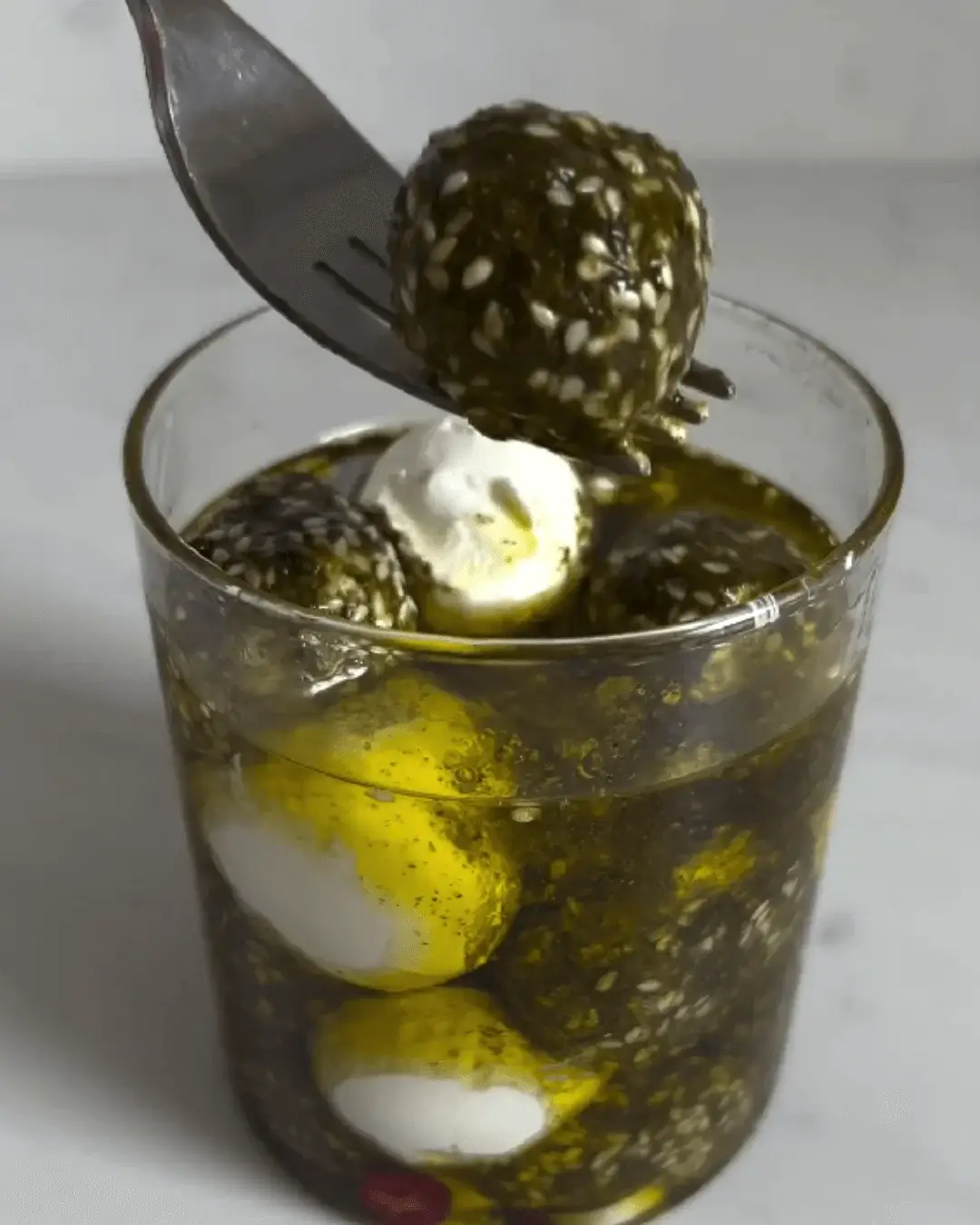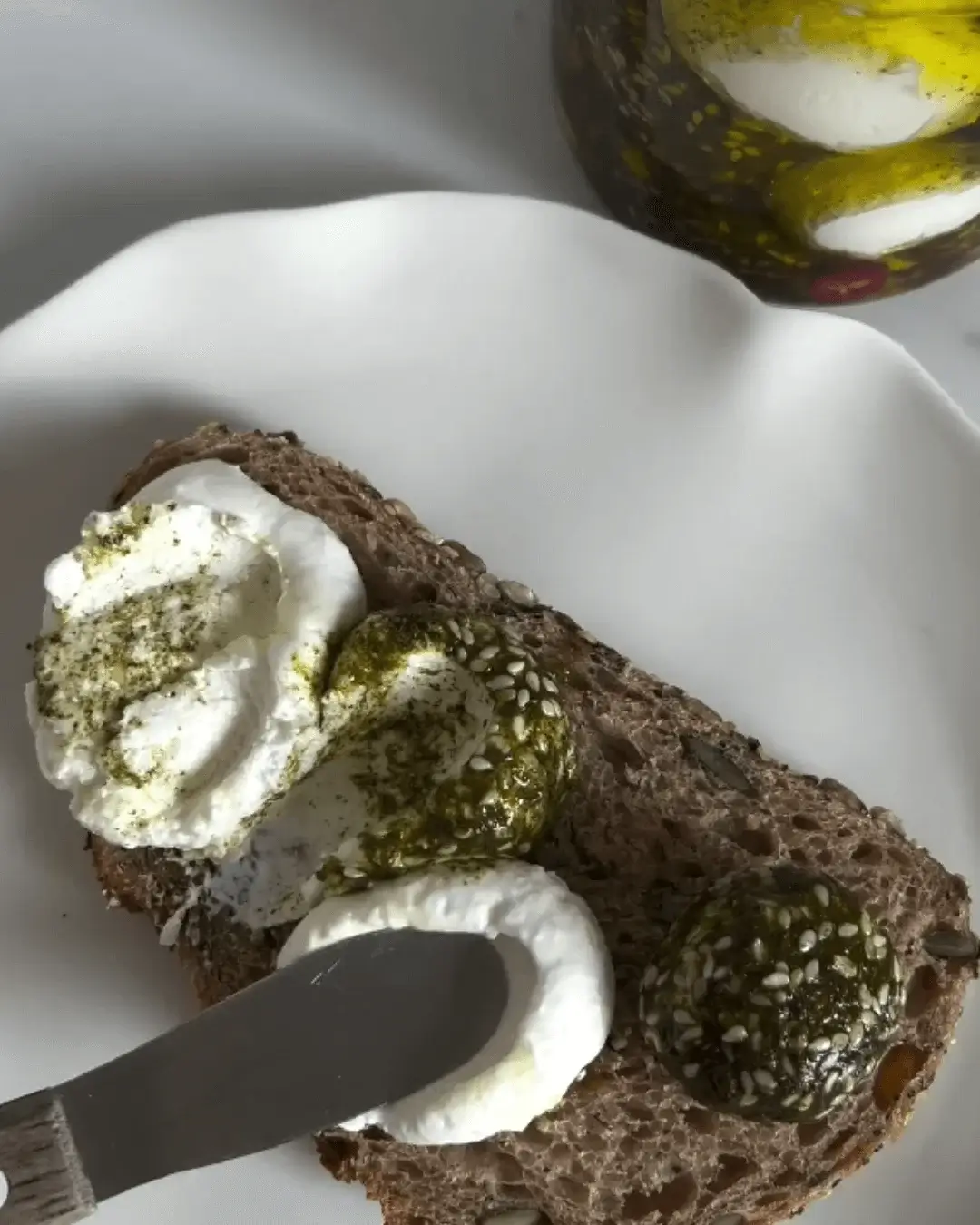Perfect Zaatar Labneh Balls Recipe You Won’t Want to Replace
We may earn a commission from recommended products, at no extra cost to you. See Disclosure.
- Cheesecloth
- 2 Mason jar
INGREDIENTS
- 6⅓ cups/1.5 liters full fat yogurt
- 1 flat tablespoon salt
- Olive oil to cover the balls in the jar
- Zaatar, for coating the balls (optional)
- 2 garlic cloves, sliced
- 1 small red chili pepper, sliced
- A few sun-dried tomatoes
INSTRUCTIONS
- Mix the yogurt with salt and pour it into a cheesecloth. Place this in a strainer with a bowl underneath to let the liquids drip out of the yogurt. Transfer to the refrigerator and wait for 12 hours (I wait 24 hours to make it really firm and ensure the liquids are well-drained).
- Grease your hands with a bit of oil and, with oiled hands, form the yogurt into balls. You can roll the balls in zaatar or leave them plain. At the bottom of a jar, place slices from 2 garlic cloves, a few slices of chili, and sun-dried tomatoes. Pour a bit of olive oil, then arrange a layer of balls on top. Finish by pouring more olive oil and store in the refrigerator.
MY NOTES

FAQ
How long can the zaatar labneh balls last in the fridge?
Zaatar labneh balls can be stored in the refrigerator for up to two weeks if kept submerged in olive oil. The oil acts as a preservative, maintaining the freshness and flavor of the labneh. Ensure the jar is sealed tightly to prevent any air from entering, which could spoil the labneh. For best results, always use clean utensils to remove the labneh balls from the jar, keeping the remaining contents uncontaminated and extending their shelf life.

Types of yogurt for this zaatar labneh balls recipe
You can use different types of yogurt for this recipe. While full-fat yogurt is recommended for a rich and creamy texture, you can use lower-fat or Greek yogurt as alternatives. Non-dairy yogurts, such as coconut or almond, can also be used to make vegan labneh balls. However, the texture and taste may vary slightly depending on the yogurt’s fat content and consistency. Experiment with different types to find your preferred flavor and texture.

What can I use as a substitute for zaatar?
If you don’t have zaatar, you can use other herbs and spices as substitutes for coating labneh balls. A mixture of dried thyme, oregano, sesame seeds, and sumac can replicate the flavor of zaatar. Alternatively, you can use dried basil, parsley, or dill for a different but delicious taste. Spice blends like Italian seasoning or herbes de Provence also work well.

How do I know if the labneh has drained enough?
You’ll know the labneh has drained enough when it reaches a thick, spreadable consistency similar to cream cheese. This usually takes about 12 to 24 hours in the refrigerator. The longer you let it drain, the firmer it will become. Check the texture by gently pressing the labneh through the cheesecloth; it should hold its shape without being too liquid. If it still seems too soft, let it drain for a few more hours until the desired consistency is achieved.

What type of bread pairs best with this labneh balls recipe?
This labneh balls recipe pair best with fresh, crusty bread like baguette, ciabatta, or sourdough. These types of bread offer a satisfying crunch and can hold up to the rich, creamy texture of the labneh. Pita bread is also a great choice, especially for scooping up the labneh and accompanying toppings. For a more rustic option, try whole-grain or multigrain bread. Lightly toasted bread enhances the flavor and adds a delightful contrast to the smooth labneh balls.
What other dishes can I use zaatar labneh balls in?
Zaatar labneh balls are versatile and can be used in various dishes. They make a delicious addition to salads, adding a creamy texture and tangy flavor. You can also serve them as a topping for pizzas, or as part of a mezze platter with olives, vegetables, and pita bread. Labneh balls work well in wraps or sandwiches, adding a rich, savory element. Additionally, they can be enjoyed on their own with a drizzle of olive oil and a sprinkle of herbs for a simple, satisfying snack.

How to make dairy free zaatar labneh balls
You can make zaatar labneh balls with non-dairy yogurt, such as coconut, almond, or soy yogurt. Look for unsweetened, thick non-dairy yogurts to achieve the right texture and flavor. The process is the same as with dairy yogurt: drain the yogurt to remove excess liquid and form it into balls. Keep in mind that the flavor and texture might vary depending on the type of non-dairy yogurt used, so choose one with a rich and creamy consistency for best results.
Can I use the leftover liquid from draining?
This liquid, known as whey, is rich in protein and can be added to smoothies, soups, or sauces for extra nutrition. You can also use it as a base for homemade bread or pancakes to add a subtle tangy flavor. Additionally, whey can be used as a natural fertilizer for plants or as a marinade for meats. Don’t throw it away—there are plenty of creative uses for this nutritious byproduct!

How to prevent the zaatar labneh balls from falling apart
To prevent labneh balls from falling apart, ensure that the yogurt is well-drained and thick before shaping. Use clean, oiled hands to form the balls, which helps keep them intact. If the labneh is too soft, let it drain longer to achieve a firmer consistency. Coat the balls gently but thoroughly in za’atar or other seasonings. Finally, store the balls submerged in olive oil in a sealed jar to keep them moist and prevent them from breaking apart.

Can I freeze the zaatar labneh balls for longer storage?
To freeze the zaatar labneh balls, place the balls on a parchment-lined baking sheet and freeze them until solid. Transfer the frozen balls to an airtight container or freezer bag, separating layers with parchment paper. When ready to use, thaw the labneh balls in the refrigerator overnight. Note that freezing may slightly alter the texture, making the labneh a bit less creamy. However, they will still be flavorful and enjoyable as a spread or appetizer.

What are the nutritional benefits of labneh balls?
Labneh balls offer several nutritional benefits, making them a healthy addition to your diet. They are rich in protein and calcium, which support muscle growth and bone health. The live cultures in labneh promote gut health by aiding digestion and boosting the immune system. Labneh balls also provide healthy fats from olive oil, which can improve heart health and reduce inflammation. Additionally, labneh is lower in lactose than regular yogurt, making it a suitable option for those with lactose intolerance. The addition of herbs like za’atar adds antioxidants and vitamins, enhancing the overall nutritional value of this delicious snack.

